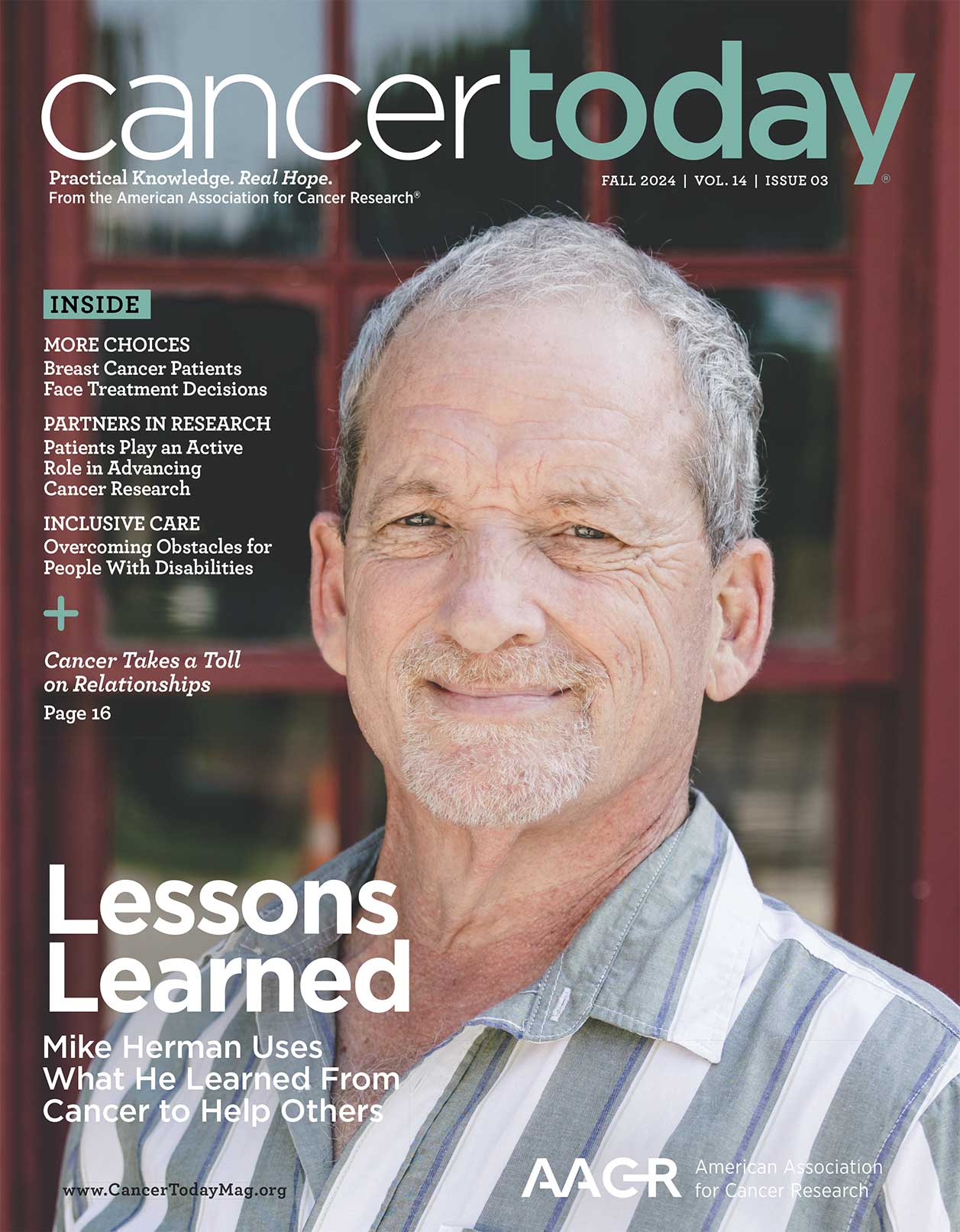Every week, the editors of Cancer Today magazine bring you the top news for cancer patients from around the internet. Stay up to date with the latest in cancer research and care by subscribing to our e-newsletter.
Uptake for Palliative Care Is Slow, Especially Among Minority Groups
The American Society of Clinical Oncology recommends patients with advanced cancer receive cancer treatment alongside palliative care, which focuses on providing relief from the symptoms and stress of serious illness, but many patients do not receive these services. In a study presented at the American Association for Cancer Research (AACR) Conference on the Science of Cancer Health Disparities in Racial/Ethnic Minorities and the Medically Underserved, held in Orlando, Florida, Sept. 29 to Oct. 2, researchers assessed palliative care use in patients with metastatic breast cancer, noting a rise from 14.9% in 2004 to 27.6% in 2020. However, the findings, which were reported Sept. 29 in Healio, also indicate a 13% lower likelihood for palliative care use among Black patients, 26% lower use among Asian/Pacific Islander patients and 35% lower use among Hispanic patients when compared with white patients. Researchers analyzed data from 148,931 people with newly diagnosed metastatic breast cancer. The results underscore the importance of promoting the benefits of palliative care and addressing racial and ethnic disparities to improve quality of life for patients with metastatic breast cancer, study presenter Jincong Freeman, a doctoral student in the department of health at the University of Chicago, told Healio. (The AACR, which hosted the disparities conference, also publishes Cancer Today.)
Shorter Courses of Radiation Highlighted at Radiation Oncology Conference
Research presented at the American Society of Radiation Oncology (ASTRO) suggests shorter radiation schedules may be equally as effective as longer ones in treating two different types of cancer. In one study, presented at the ASTRO Annual Meeting on Oct. 1, researchers noted that a shorter course of radiation therapy with hypofractionated radiation after mastectomy and breast reconstruction surgery provides the same protection against breast cancer recurrence as conventional radiation. In the study, participants were randomized to receive either hypofractionated radiation, which delivers more doses of radiation per treatment, over roughly three weeks or conventional radiation for five weeks. Participants in both groups had equivalent physical side effects, but those who were treated with hypofractionated radiation had substantially reduced life disruption and financial burden, according to a statement released by ASTRO. In a separate study presented at the conference, researcher studied the use of stereotactic body radiation therapy (SBRT), which delivers precise, intense doses of radiation to tumors while sparing healthy tissue, in men with intermediate risk, localized prostate cancer. SBRT was delivered over five treatment sessions and was just as effective as conventional radiation delivered in more than 20 treatment sessions over several weeks. “It’s fantastic to see that this new type of multibeam therapy appears to be just as effective as traditional radiotherapy and could help men get treated more quickly and with far fewer visits to the hospital,” said Simon Grieveson, assistant director of research at Prostate Cancer UK, in the Guardian, which provided an analysis of the findings.
FDA Panel Questions Data From Lung Cancer Drug Study
A Food and Drug Administration (FDA) panel raised questions about the final data submitted by Amgen for traditional approval of the lung cancer drug Lumakras (sotorasib), noting that the study that generated the data had systemic bias. The FDA granted Lumakras accelerated approval in 2021, making it the first KRAS inhibitor to reach the U.S. market. Under the accelerated approval pathway, the drug company needs to provide confirmatory data to gain traditional approval for the drug. The confirmatory study analyzed progression-free survival (PFS), a measure of how long before the disease begins to worsen. The drug reduced the risk of disease progress in patients with advanced lung cancer by 34% compared with chemotherapy, but it did not seem to have an effect on overall survival. An FDA spokesperson, quoted in a story for Reuters, said the agency cannot comment on its next steps, but that it intends to keep the drug available for patients for now. The agency is expected to make a final decision by Dec. 24, Reuters reports. Lumakras is approved for patients with advanced lung cancer who have a mutation in the KRAS gene and whose disease has worsened after chemotherapy and other treatments.
Patient’s Experience Highlights Burden of Cancer Treatment Costs in Alaska
In 2022, Emily Gebel, who lives in Juneau, Alaska, decided to travel to receive treatment for her breast cancer in Seattle, on the advice of friends who told her to seek care in a major city. However, after learning her cancer was metastatic, Gebel decided the weekly travel was too tiring and sought care closer to home. The surprise came when Gebel, who had already met her out-of-pocket maximum spending limit, received the bill from the Bartlett Regional Hospital in Juneau. For one infusion, her bill at the hospital in Alaska was more than three times the price for a similar mix of drugs at the Seattle clinic, NPR reports. The prices of medical services can vary between facilities, the article notes, and remote locations, like Juneau, can have particularly expensive care. To treat cancer patients, Bartlett Regional Hospital flies in two oncologists who live outside the city six times a month, a hospital spokesperson said. The article notes that research shows Alaskans seek emergency care and are admitted to the hospital less often than many Americans, but the state had the third-highest health care expenditures per capita in 2020.
Cancer Today magazine is free to cancer patients, survivors and caregivers who live in the U.S. Subscribe here to receive four issues per year.





